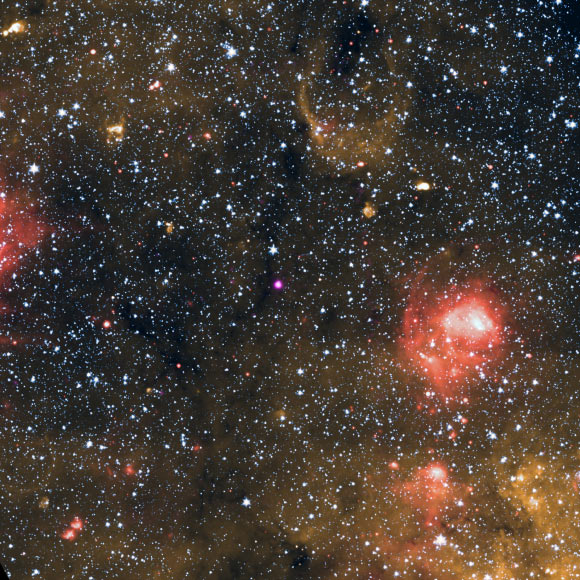Astronomers using NASA’s Chandra X-ray Observatory have studied Swift J1818.0-1607, a new magnetar (a type of neutron star with an extremely powerful magnetic field) discovered by the Swift Burst Alert Telescope on board NASA’s Neil Gehrels Swift Observatory on March 12, 2020, and the effect of magnetar-like outbursts on its surrounding.

This composite image of Swift J1818.0-1607 contains a wide field of view in the infrared from NASA’s Spitzer Space Telescope and Wide-Field Infrared Survey Explorer, taken before the magnetar’s discovery. X-rays from Chandra show the magnetar in purple. Image credit: NASA / CXC / University of West Virginia / H. Blumer / JPL / Caltech / Spitzer.
Swift J1818.0-1607, which is located about 21,000 light-years away in the constellation of Sagittarius, has a magnetic field up to 1,000 times stronger than a typical neutron star.
At about 470 years old, the object is both the youngest neutron star and the youngest magnetar ever discovered.
It is also one of the fastest-spinning such objects known, whirling around once every 1.36 seconds — despite containing the mass of two solar masses within a stellar remnant measuring just 25 km across.
Chandra’s observations of Swift J1818.0-1607 obtained less than a month after the discovery with Swift gave astronomers the first high-resolution view of this object in X-rays.
The data revealed a point source where the magnetar was located, which is surrounded by diffuse X-ray emission, likely caused by X-rays reflecting off dust located in its vicinity.
Radio observations by the 100-m Effelsberg radio telescope identified Swift J1818.0-1607 as the fifth radio-loud magnetar.
This implies that it also has properties similar to that of a typical rotation-powered pulsar, a type of neutron star that gives off beams of radiation that are detected as repeating pulses of emission as it rotates and slows down.
Only five magnetars including this one have been recorded to also act like pulsars, constituting less than 0.2% of the known neutron star population.
In new research, Dr. Harsha Blumer of West Virginia University and Dr. Samar Safi-Harb from the University of Manitoba studied how efficiently Swift J1818.0-1607 is converting energy from its decreasing rate of spin into X-rays.
They concluded this efficiency is lower than that typically found for magnetars, and likely within the range found for other rotation-powered pulsars.
The explosion that created a magnetar of this age would be expected to have left behind a detectable debris field.
To search for this supernova remnant, the astronomers looked at X-rays from Chandra, the infrared data from NASA’s Spitzer Space Telescope, and the radio data from NSF’s Karl G. Jansky Very Large Array (VLA).
Based on the Spitzer and VLA data they found possible evidence for a remnant, but at a relatively large distance away from the magnetar.
In order to cover this distance the magnetar would need to have traveled at speeds far exceeding those of the fastest known neutron stars, even assuming it is much older than expected, which would allow more travel time.
“The sensitivity and resolution offered by Chandra allowed us to study the recently discovered magnetar Swift J1818.0-1607 and resolve compact faint emission surrounding it,” the researchers concluded.
“Our study points to Swift J1818.0-1607 being a transient source showing properties intermediate between high-B pulsars and magnetars, and to the diffuse emission being dominated by a dust scattering halo.”
“Future deep Chandra observations of the source in quiescence will confirm the nature of this extended emission and place further constraints on any underlying compact wind nebula powered by the rotational energy loss of the pulsar.”
The findings were published in the Astrophysical Journal Letters.
_____
Harsha Blumer & Samar Safi-Harb. 2020. Chandra Observations of the Newly Discovered Magnetar Swift J1818.0-1607. ApJL 904, L19; doi: 10.3847/2041-8213/abc6a2







